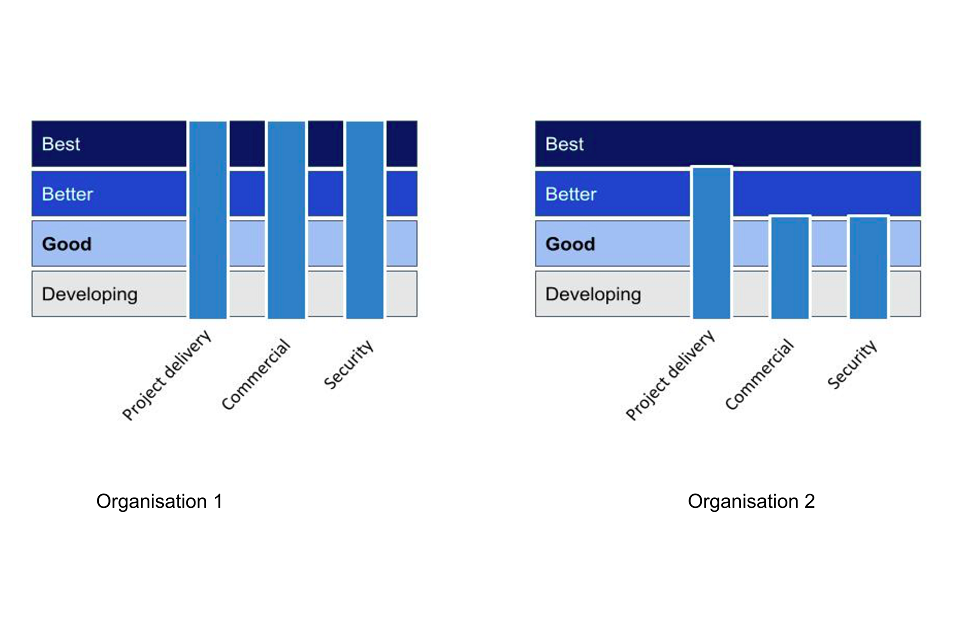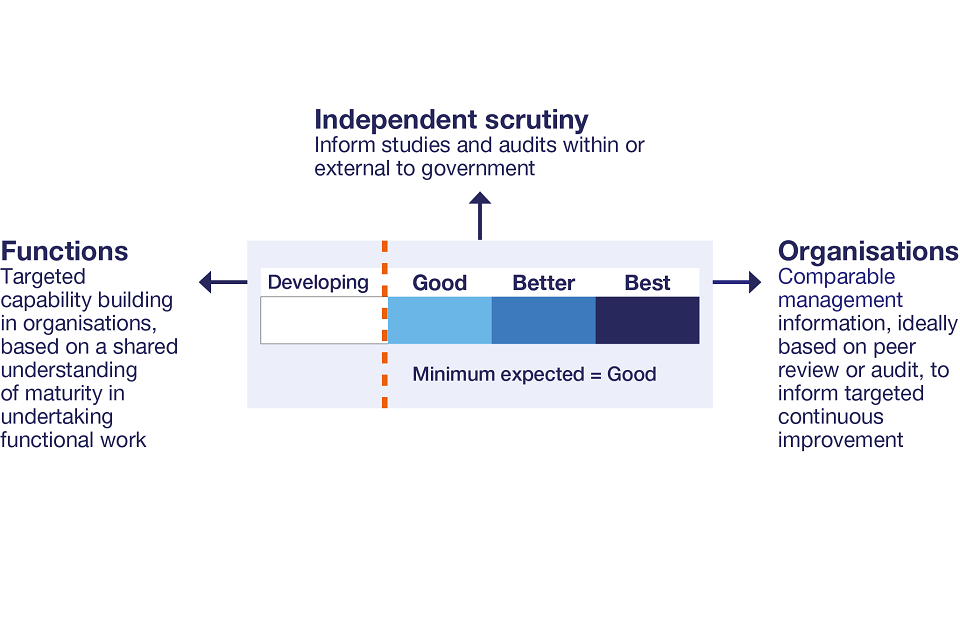Guide to continuous improvement against functional standards
Published 16 July 2021
1. About this guide
This guide explains how assessment against functional standards can be used to improve the way functional work is done in government. It is for anyone leading or contributing to strategies, plans or continuous improvement initiatives that involve functional work.
2. Continuous improvement assessment frameworks
A continuous improvement assessment framework is a management tool designed to provide consistent, comparable management information to support functional assurance and continuous improvement, which:
- sets levels of maturity against the most important aspects of a standard (good, better or best)
- makes it easy for organisations to understand how well they are doing and where they should aim to improve
- enables peer review and peer support
- can be used to evidence improvement over time
The assessment framework does not dilute or take the place of the relevant functional standard, which should be followed in full.
A functional standard contains mandatory, advisory and permitted elements and uses active language to set expectations (‘shall’, ‘should’ etc).
The associated continuous improvement assessment framework sets out what should be present or observable in an organisation to reach maturity levels, so uses ‘is’ and ‘are’ statements.
For background on functional standards, please see the Guide to functional standards.
For information on assessment against specific functional standards, please follow the links from individual functional pages or contact the relevant functional team. See the Project delivery assessment framework for an example of an assessment framework.
3. A stable basis for continuous improvement
Once established, a functional standard is likely to be quite stable. This creates certainty about what is expected, and enables convergence over time towards an effective, coherent and integrated system (particularly when other requirements and guidance are fully aligned to the standards).
The combination of mandatory (shall) and advisory (should) elements makes it possible to set a continuous improvement route tailored to the needs and priorities of a business. Once compliant with the mandatory elements, organisations can prioritise the advisory elements that are most important to them.
Functions have a stable basis against which to define the skills, knowledge and experience needed to do functional work in government.
4. Why consistent assessment matters
Pooling functional resources to create and manage shared, consistent assessment frameworks should save individual organisations time and money.
Over time, consistent assessment means:
- Senior leaders and internal and independent assurance bodies have access to a common set of assessments across organisations, to inform their work
- Organisations have a stable and consistent basis for review and assurance of functions, and a basis for comparison against peer organisations, helping them to plan for continuous improvement and delivery of their priorities
- Functions understand compliance across organisations and have cross-government comparisons to inform deployment of additional support to organisations that need it most
It is not necessary to coordinate the timing of assessments across functions or between organisations because they can be comparable even if done at a different point in time.
See also the Functional Standards common glossary for the definitions used across the suite of functional standards, which are also used consistently in assessment frameworks.
5. Good, better, best
Continuous improvement assessment frameworks set out different levels of maturity against the most important aspects of a functional standard - from the minimum expected (good), to better and best, as shown in the diagram below. Some functions may align ‘good’ to existing levels of expected practice.
Assessment frameworks are based on statements drawn from the functional standard, weighted for importance.
Good means that all mandatory elements, and the most important advisory elements, are met. In order to be good, better or best, an organisation would need to meet all the criteria for that level across the framework.
By default an organisation is ‘developing’ if it doesn’t meet at least ‘good’ for all the criteria. For this reason, continuous improvement assessment frameworks do not include criteria for ‘developing’.

Figure 1: Good, better, best
6. Setting ambition for improvement
Organisations should set their ambition based on business need. For each functional area of work, do they need to be good, better or best?
Assessments focus on one function at a time, but in practice an organisation would be interested in a number of functions working together, and want to plan how well they need to meet a combination of standards.
For some organisations good might be 'good enough', because they are not heavily reliant on the work of a particular function to operate effectively. Other organisations will decide they need to be 'best', based on the priority and complexity of the functional work that they do.
The figure below illustrates how levels of ambition can be set to meet the needs of a business. Organisation 1 decides it needs to be best across several functions, whereas organisation 2 decides it can aim for good or better:
Organisation 1:
Organisation 2:

Figure 2: Different ambition for different organisations
By setting ambition for each function, and understanding how well it is doing against its ambition, the organisation can set continuous improvement priorities for its most important functional work.
Functions can offer tailored support to high priority work where the capability or capacity gaps are widest. They can also use insights from assessments to develop and strengthen overall functional strategies, plans and reporting.
7. Undertaking assessments
To avoid overload in organisations, assessments should be undertaken as part of routine assurance and to suit the organisation, rather than an additional process for accounting officers to engage with.
A function should work with organisations to define:
- organisations in scope
- who should be involved in the assessment
- when assessments should happen
Before starting an assessment, the boundaries of the organisation being assessed should be defined. A whole government department or arm's length body can be covered, or the assessment can be limited to a defined part. Avoid defining the boundaries in terms of a specific discipline, as the perceived remit of the associated management team will be too narrow for the themes, practice areas and assessment criteria drawn from the standard.
Assessments are likely to rely primarily on organisations undertaking self assessment, with results shared with the centre of the function. Functions would provide separate guidance for assessors, as necessary.
Attitude is key. Assessment will add no value unless there is objectivity and honesty in response to the criteria. This is about 'getting better', not 'looking good'. Feedback loops and benchmarking encourage realism and enable peer support.
Those leading assessment should:
- encourage peer review and comparison within and between organisations
- reassure people that assessment is a continuous improvement initiative, not a threat, and is focused on facilitating honest self-appraisal and improvement action
- balance the need to evidence metrics against the effort required to collect such metrics
- keep track of the trajectory of the organisation in terms of meeting the mandatory and advisory elements of each standard over time
- acknowledge that some people won’t have enough experience to recognise their organisation’s limitations
Each organisation has a different starting point, and some might want to implement assessment gently at first, with functions providing tailored help for those organisations that need it.
8. Using assessments
Completed assessments against functional standards provide a consistent way for organisations to understand how well their practices are meeting the standard, and thus how their overall performance is likely to be improving (or not).
This should help with existing tasks such as Accounting Officer system statements and Annual reports and Accounts.
Completed assessments can be used as input to organisational, functional and cross-government management. For example setting organisational strategy, undertaking business planning and monitoring business performance, setting functional strategies and plans, and as input to independent assurance. See figure 3 below

Figure 3: Assessment supports improvement activities (source:GovS 001, Government functions)
Normal assurance activities would usually spot if a function or organisation is being overly optimistic or pessimistic in its self-assessment. The best organisations generally mark themselves harder than good ones.
Functions can use intelligence gained from continuous improvement assessment frameworks to inform the setting of priority activity in function plans, and to report progress against plan.
9. Publication
Functions may publish their continuous improvement assessment frameworks, setting out the themes, practice areas and criteria used for assessment, as a separate document aligned to the functional standard. For an example, see the Project delivery page.
Completed assessments support internal management, and are not intended for publication either proactively or in response to information requests. This ensures a trusting environment to facilitate realistic assessments, and free and frank discussion.
10. Find out more
For details about undertaking assessment against specific functional standards, please follow the link to the relevant standard to find the latest information, and contact details for the functional team.
For general queries about functional standards, please contact standards@cabinetoffice.gov.uk .
